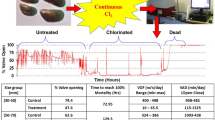Abstract
Perna perna (L.), the edible brown mussel, is very widely distributed in the tropical and subtropical regions and is commonly found in rocky shores. Apart from being a candidate for commercial cultivation, P. perna is also a common pest organism in cooling water systems of coastal power stations. Therefore, a lethal and sublethal response of this mussel to commonly used antifouling biocides is of considerable interest to the industry. Mortality pattern (LT50 and LT100) and physiological activities (oxygen consumption, filtration rate, foot activity index, and byssus thread production) of different size groups (9–34 mm shell lengths) of P. perna were studied in the laboratory under different residual chlorine concentrations (0.25, 0.50, 0.75, and 1.00 mg/L for sublethal responses and 1, 2, 3, and 5 mg/L for mortality). Results showed that exposure time for 100% mortality of mussels significantly decreased with increasing residual chlorine concentration. For example, mussels of 9 mm size group exposed to 1 mg/L chlorine residual took 384 h (16 days) to reach 100% mortality, whereas those exposed to 5 mg/L chlorine took 84 h (4 days). The effect of mussel size on mortality was significant between 1 mg/L and 5 mg/L residual chlorine, with larger mussels showing greater resistance than smaller ones. For example, at 2 mg/L residual chlorine, 9 mm and 34 mm size group mussels took 228 h (10 days) and 304 h (13 days), respectively, to achieve 100% mortality. All size groups of P. perna showed progressive reduction in physiological activities, when chlorine residuals were gradually increased from 0 to 1 mg/L. Reduction in physiological activities was strongly correlated with the residual level. A comparison of present data with data available for other common fouling organisms suggests that P. perna is relatively less tolerant to chlorine than Perna viridis (L.) and Brachidontes striatulus (Hanley), which also cause fouling problems in tropical coastal waters.
Similar content being viewed by others
Author information
Authors and Affiliations
Additional information
Received: 2 May 2002/Accepted: 5 September 2002
Rights and permissions
About this article
Cite this article
Rajagopal, S., Venugopalan, V., van der Velde, G. et al. Response of Fouling Brown Mussel, Perna perna (L.), to Chlorine. Arch. Environ. Contam. Toxicol. 44, 0369–0376 (2003). https://doi.org/10.1007/s00244-002-2098-y
Issue Date:
DOI: https://doi.org/10.1007/s00244-002-2098-y




